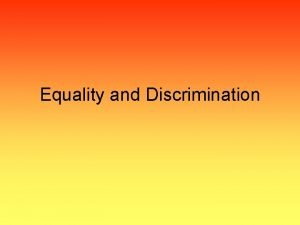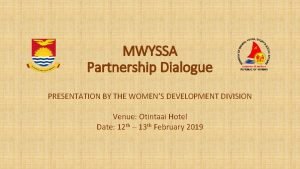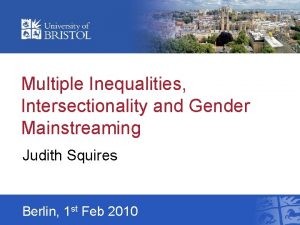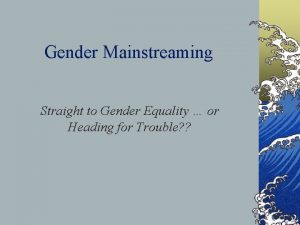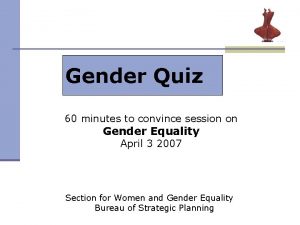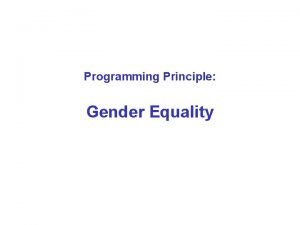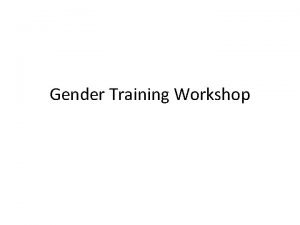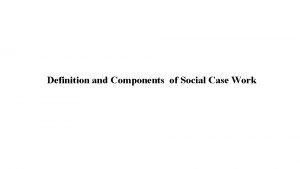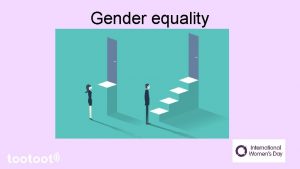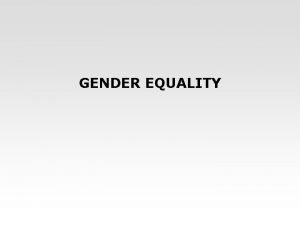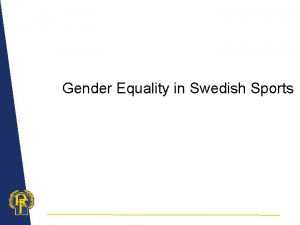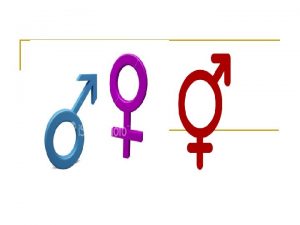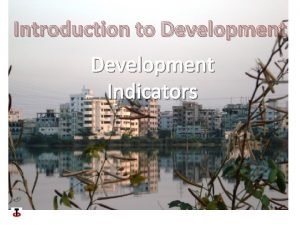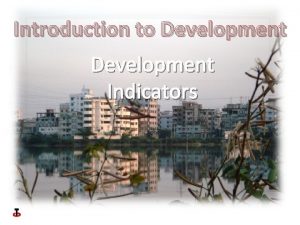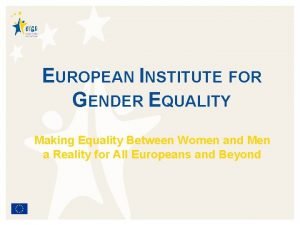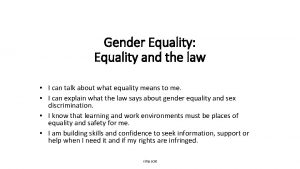Indicators of Gender Equality Work session on Gender



















- Slides: 19

Indicators of Gender Equality Work session on Gender Statistics Geneva, 12 -14 March 2012 Discussant - Helen Cahill CSO Ireland

Why do Gender Indicators matter? �“. . Achievement of equality between women and men. . A matter of human rights. . ” (Beijing Platform for Action) �“. . Gender indicators. . Measure whether or to what extent gender equality is being achieved. . ” �What is measured gets attention!!

UNECE Task Force on Indicators of Gender Equality �Compiling gender equality indicators for the UNECE region �Starting point = minimum set of gender indicators being compiled by UN Advisory Group on Gender Statistics Database and Indicators �Set of indicators will be fairly small �Hierarchy of headline and supporting indicators �Outlined the selection criteria being used �Named the domains on which the Task Force is focusing

European Gender Equality Institute �Introducing the composite European Gender Equality Index (GEI) over a set of domains �Aim to propose a set of dimensions which adequately map the concept of gender equality �Main starting point is EU’s gender equality policy which has 2 overall objectives: �Equal distribution �Dignity and integrity

Statistical Office of the European Union �Introducing dedicated area on Gender equality indicators launched on Eurostat website �Main purpose to extend the visibility of gender statistics �Not to duplicate work done elsewhere �Indicators were chosen based on EU policies (e. g. , Women’s charter 2010) �Main criteria used in selection were: �Relevance, data availability, comparability, easy to understand

Statistics Lithuania �Reviews work on developing and producing data on gender statistics and indicators of gender equality �“. . Statistics that reflect the differing realities of women’s and men’s lives are required to promote equality between the sexes. . ” �As gender issues become more important in Lithuania, data users say that the gender perspective should be a basic assumption guiding which data to collect and analyze.

FAO core gender indicators in Agriculture �Linked to 5 assets of DFID Sustainable Livelihoods Framework (human, natural, financial, physical, social) �And integrated with basic questions from FAO SEAGA framework: �Who does what? Who owns what? Who has access to/controls what? �Then linked to WCA and previous work by FAO on gender indicators in agriculture �Set of 18 core indicators: 16 on livelihood assets and 2 on livelihood strategies

FAO core gender indicators in Agriculture �Core indicators - Census of Agriculture in Moldova �Most core indicators can be calculated from the WCA �Basic statistical unit is holding/household �Core indicators will give basic picture of the socioeconomic status of women and men involved in agriculture at the holding/household level �Further consultations with more member countries recommended to assess the current availability of the core indicators

UNECE paper �Gender indicators “. . . Highlight the contributions of men and women. . . and their different needs and problems” �In isolation the interpretation of some indicators may be misleading �Growing awareness that full understanding of gender imbalances requires a broad focus �For example, when seeking to understand labour statistics it is important that we look beyond employment and unemployment rates

Ireland: recession or mancession? �Construction boom in Ireland masked changes in labour market Dwellings completed 100, 000 90, 000 80, 000 70, 000 60, 000 50, 000 . . . 40, 000 30, 000 20, 000 10, 000 0 1995 2000 2005 2010

Ireland: employment and unemployment Male unemployment Female unemployment Male employment Female employment 90 80 70 60 50 40 30 20 10 0 2002 2003 2004 2005 2006 2007 2008 2009 2010 2011

Ireland: Participation rates Male participation Female participation Total participation 80 75 70 65 % Participation rate 60 55 50 45 40 2001 2002 2003 2004 2005 2006 2007 2008 2009 2010 2011

Ireland Unemployment rate for young people Men aged 20 -24 Men aged 25 -34 Women aged 20 -24 Women aged 25 -34 35 30 25 20 % 15 10 5 0 2001 2004 2007 2010

Background �Early school leavers rate: � 2005 Male 15. 4% Female 12. 6% � 2010 Male 12. 6% Female 8. 4% �School leaving exam results (age 18): Girls consistently outperform boys �Third level education for those aged 25 -34: � 2005 Male 35. 2% Female 44. 6% � 2011 Male 39. 1% Female 53. 1%

Mancession*: a recession with disproportionate effect on men �In the past, less-educated young men found manual jobs in manufacturing – this sector of the economy has been in decline for many years now in Ireland �The construction boom offset the reduction in manual manufacturing jobs �However the bubble bursting in construction has exposed the implications for young men of not going on for further education/training �(*Thanks to newspaper article by David Mc. Williams)

Eurostat EIGE UNECE Labour market Work Women & economy Earnings & social inclusion Money Women & Poverty (see note 1) Power Women in power Health Women & Health Harm Violence against women Education Knowledge Education & training of women Childcare Time Aggravating factors Note 1: Indicators on women in decision making on DG Justice database. Note 2: UNECE will also pay attention to 5 domains for which less information is available.

Questions for presenters �European Institute for Gender Equality: �What weights will be used? �Will they consider headline and supporting indicators? � UNECE: �Likely timescale? �Can we see provisional list of indicators? �Has a composite index been considered?

Questions for presenters �Eurostat: �Could indicators from DG Justice database on women in decision making be hosted on Eurostat website also? �Of the gender equality indicators on Eurostat website, which are the most popular for users? �Lithuania: �Does area of gender statistics come under pressure in this time of economic downturn? �What are the reasons why more women were employed than men in 2010?

Suggestions to delegates �Questions for the presenters? ? �Do you think that the domains covered by Eurostat, UNECE and EIGE are adequate? �Do you believe that all important policy issues have been covered? �Please share specific examples of your national experiences as they relate to points raised in the presentations
 Formal and substantive equality
Formal and substantive equality Cedaw articles
Cedaw articles Mwyssa
Mwyssa Rhetorical questions about gender equality
Rhetorical questions about gender equality Gender equality definition
Gender equality definition What is gender equality answer
What is gender equality answer Methodology of gender inequality
Methodology of gender inequality Conclusion of kothari commission
Conclusion of kothari commission Short poem on gender equality
Short poem on gender equality Example of gender equality
Example of gender equality Slogan about discrimination
Slogan about discrimination What is gender equality answer
What is gender equality answer Strategic gender needs and practical gender needs
Strategic gender needs and practical gender needs Conflict resolution work immersion
Conflict resolution work immersion Conflict resolution work immersion
Conflict resolution work immersion Smart vs hard working
Smart vs hard working Present continuous con always
Present continuous con always Preventive model in social group work
Preventive model in social group work Case-work définition
Case-work définition Team vs group
Team vs group
